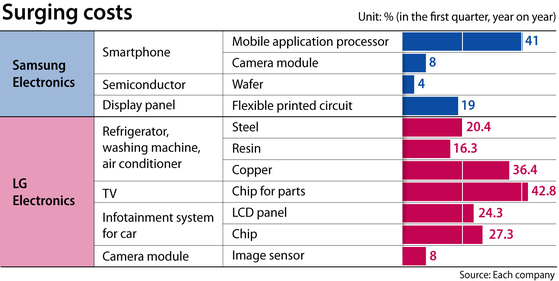Electronic consumer product parts are getting pricier
![A semiconductor wafer is displayed at a Samsung Electronics' showroom in Seocho District, southern Seoul. [NEWS1]](https://koreajoongangdaily.joins.com/data/photo/2022/05/19/bda6fc5c-9fa9-4d85-8373-a31359398b9c.jpg)
A semiconductor wafer is displayed at a Samsung Electronics' showroom in Seocho District, southern Seoul. [NEWS1]
Rising chip prices and freight costs are being felt by Korea's electronic consumer product manufacturers.
According to an interim business report by Samsung Electronics issued Wednesday, the company had to pay 41 percent more for a smartphone mobile application processor (AP) in the first quarter compared to the same period last year. Suppliers of the chips to Samsung include Qualcomm in the U.S. and Taiwan’s MediaTek.
Other key components got pricier too. Camera modules for smartphones were 8 percent more expensive in the first quarter compared to a year earlier, and semiconductor wafers 4 percent. Flexible printed circuit prices rose 19 percent and tempered glass for TV and monitor displays 2 percent.
However, prices of display panels, which include liquid crystal display (LCD) panels, declined 42 percent from the same period last year due to slumping LCD demand.
LG Electronics also spent more on parts procurement in the January-March period.
Prices for steel, resins and copper, all used in home appliances, grew 20.4 percent, 16.3 percent, and 36.4 percent compared to the same period in 2021, LG Electronics said.
Chips for TVs and audio/visual equipment increased 42.8 percent in price on year. LCD panels and chips for infotainment systems in cars cost LG 24.3 percent and 27.3 percent more. LCD panels for TVs were the only key component that got cheaper during the first quarter, by 15.6 percent.

Meanwhile, the war in Ukraine and China’s Covid-19 lockdowns pushed up shipping costs.
Samsung Electronics spent 857.6 billion won ($672.7 million) on shipping during the first quarter, a 40.9 percent increase compared to the same period last year. LG Electronics spent 1.08 trillion won, up 52.0 percent from last year.
Companies are pondering ways to deal with cost increases, with price hikes an obvious option.
Samsung Electronics set up a task force last year to stabilize its global supply chains. LG Electronics established supply monitoring task forces in each department.
“Though the situation may differ for each product, product prices naturally go up in line with the rise in costs,” said an industry insider. “But we cannot easily increase prices either.”
Companies worry that price hikes will nip sales in the bud as so-called revenge spending that followed Covid lockdowns in many countries tapers off.
Samsung Electronics was reported to be planning a 15- to 20-percent price increase for contract chip fabrication following TSMC’s recent single-digit percentage price rise, according to Bloomberg.
Industry analysts forecast that Samsung’s price increase in its foundry business could drive electronics prices up across the market.
“Component cost pressures won’t go away for a while due to strong demand and supply disruptions,” said Eugene Investment analyst Lee Seung-woo.
“Companies are grappling with the issue, since they cannot immediately raise prices despite surging costs on all sides and gradually rising consumer prices may stifle demand,” said Lee.
BY CHOI EUN-KYUNG [shin.hanee@joongang.co.kr]










with the Korea JoongAng Daily
To write comments, please log in to one of the accounts.
Standards Board Policy (0/250자)